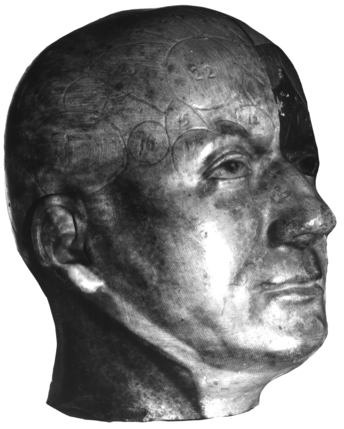Franz Joseph Gall1758–1828
Gall represents the emergence of medicine and physiology as sources of psychological speculation. From the early nineteenth century, anatomists dissected neural pathways in the brain with increasing precision and these were related to the developing understanding of nerve transmission. These anatomical and physiological discoveries were applied to individual differences in the gross structure of the brain and to disorders of its function due to trauma or disease. Gall’s studies on the spinal cord, using a comparative approach, were of particular importance, because they showed that this part of the central nervous system is not only an appendix of the brain (as was commonly held at the time), but is endowed with its own functional capabilities (especially in lower vertebrates). Gall was born in Germany, studied medicine in Strasbourg and practiced in Vienna, where he gained a reputation as one of the leading neuroanatomists in Europe. In 1791 he advocated cortical localisation of mental functions; he drew a clear distinction between the grey matter of the cerebral cortex and the underlying white matter. These advances were described long before his publications on phrenology, with his collaborator, Johann Gaspar Spurzheim. However, it is for phrenology - assessing mental characteristics from the external shape of the skull - that Gall is best known. In the early nineteenth century, after losing his stipend in Vienna for publishing such novel ideas about brain function, he made an enormously successful tour of European capitals (together with Spurzheim) lecturing on and demonstrating phrenology. In Paris phrenology was subjected to examination by a Royal Commission (on which Pinel sat), as had animal magnetism, and with a similar negative conclusion. On the one hand, phrenology became a popular pursuit, developing absurdly specific “cranioscopical inferences” and making extravagant claims which led to its eventual ridicule and demise. On the other hand, it focused attention on functions carried out in local regions of the brain, in contrast to earlier views of its equipotentiality. For example, Gall proposed that the nerve ganglia were hierarchically organized, that the source of behaviour was in the cortex, and that different varieties of memory were localized in the frontal cortex as was the function of speech. “In all my researches, my object has been to find out the laws of organization, and the functions of the nervous system in general, and of the brain in particular... The moral and intellectual dispositions are innate; their manifestation depends on organization; the brain is exclusively the organ of the mind; the brain is composed of many particular and independent organs, as there are fundamental powers of the mind; - these four incontestable principles form the basis of the whole physiology of the brain.” Although Gall’s phrenological opinions would be discredited, they played an important historical role in the emergence of the theory of cerebral localization. They received a particular attention from the French medical milieu and acted in promoting the first localization of language areas in the brain by Broca. The sculpted head of Gall shown here has phrenological markings on both sides, but those on the left of the original are coloured as well as numbered. The head has been orientated to match that of a lithographic portrait of Gall. A slide of the portrait was projected onto the head and photographed so that the facial details of the portrait were superimposed on the model.
